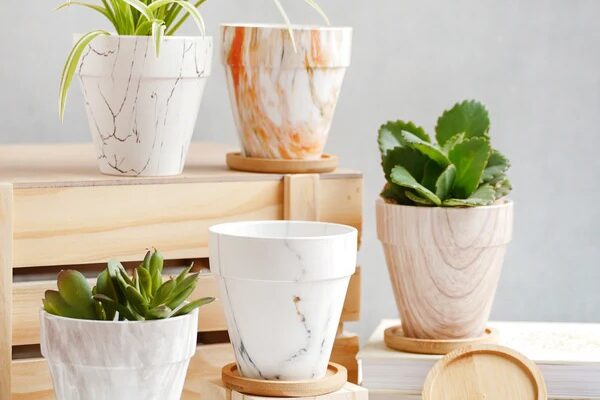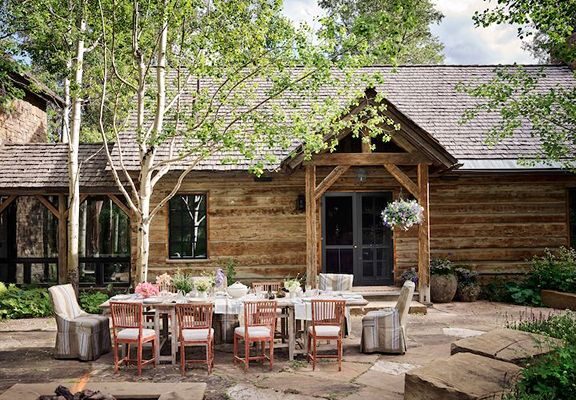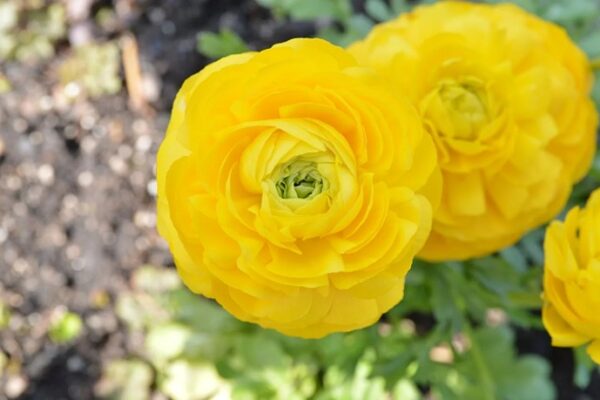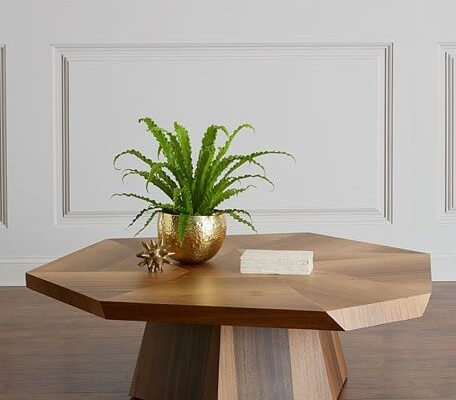A Success to Grow and Care for Bougainvillea
If you want to enhance the beauty and charm of your garden, you can grow and care for bougainvillea, a vibrant and low-maintenance plant. With proper attention and care, bougainvillea can thrive and provide stunning blooms year-round. Growing and caring for bougainvillea requires knowledge of proper techniques and regular maintenance to ensure its healthy growth and vibrant blooms.
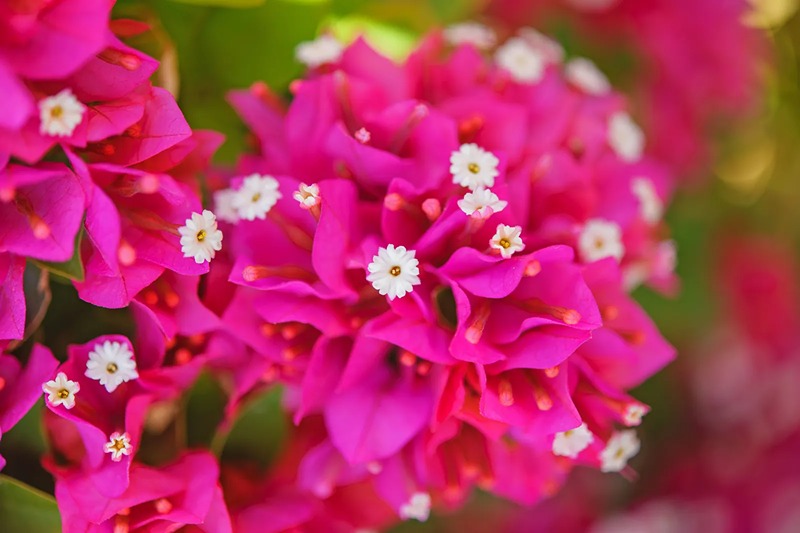
Bougainvillea is a stunning plant that effortlessly enhances the beauty of any space it occupies. With its vibrant and eye-catching bracts in a myriad of colors, including shades of pink, orange, red, purple, and yellow, bougainvillea adds a burst of color and charm to gardens, courtyards, and balconies. Whether trained to climb up trellises and fences, cascading gracefully from hanging baskets, or adorning the ground as a lush ground cover, bougainvillea creates a captivating visual display.
Its abundant and long-lasting blooms create a sense of joy and vibrancy, transforming any landscape into a vibrant oasis. With its ability to thrive in warm climates and its resilience to drought and disease, bougainvillea is a natural choice for adding a touch of elegance and allure to outdoor spaces, making them more inviting and visually appealing.

What Are Bougainvillea’s?
Bougainvilleas are vibrant and ornamental plants characterized by their thorny nature. They can be found in various forms, including vines, bushes, and even trees, and are primarily renowned for their striking fuchsia-colored bracts, which surround the actual flowers. Bougainvillea thrives in warm climates, making it a popular choice in tropical regions.
The two most prevalent species of bougainvillea are Bougainvillea glabra and Bougainvillea spectabilis. These species exhibit a wide range of bract colors, which can vary depending on the specific variety or cultivar. However, it’s important to note that these bracts do not engage in photosynthesis like regular leaves do. Instead, they serve as protective structures for the delicate white blooms nestled at their core, representing the true flowers of the plant.
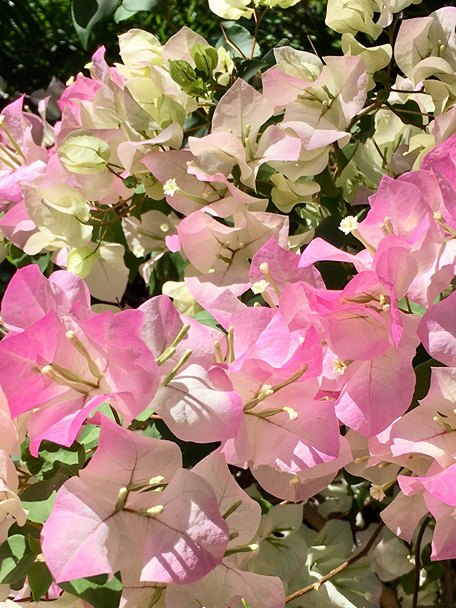
Belonging to the Nyctaginaceae family, commonly referred to as the four o’clock family of plants, bougainvillea possesses several desirable traits. They are known for their ability to withstand drought conditions, making them highly tolerant to water scarcity. Furthermore, bougainvillea showcases remarkable resistance to diseases, contributing to its overall hardiness. Additionally, these plants are relatively easy to cultivate, exhibiting robust growth patterns.
Bougainvillea can be versatile in their growth habits, making them suitable for various purposes. They can be cultivated as ground cover, cascading beautifully from hanging baskets, or trained to climb up trellises. Moreover, their adaptability extends to being grown in pots as houseplants, adding a touch of tropical elegance to indoor spaces.
How to Grow and Care for Bougainvillea
To successfully grow and care for bougainvillea, it is essential to provide optimal growing conditions, including proper sunlight, well-draining soil, and regular pruning and watering. Here is detail:
1. Take into account the climate
It is essential to consider your location and the current season before planting bougainvillea. Bougainvillea is well-suited for USDA Plant Hardiness Zone 9b and should be planted in early spring. In regions with colder climates, where bougainvillea’s do not thrive, they become deciduous plants that shed their leaves annually when temperatures drop below freezing.
2. Ensure proper sunlight
Bougainvilleas require full sun, so it’s crucial to choose the sunniest spot in your garden when planting them to maximize their blooming cycle.
3. Select suitable soil
The soil for bougainvillea should be slightly acidic, gritty, and loose. While some locations naturally provide ideal soil conditions for growing bougainvillea, you may need to adjust the acidity of your soil using an appropriate potting mix. Ensure there is enough soil for root development, but avoid excessive moisture retention, which can lead to root rot. When planting bougainvillea, handle the root ball with care, as it is delicate until the plant becomes established in its new environment.

4. Train the plants for climbing
If you desire your bougainvillea to climb up or around a structure, such as a trellis or fence, you need to train the plants accordingly. When new shoots emerge, gently arrange and guide them through open spaces in the trellis or other support structure. Repeat this process as additional shoots appear. In the absence of natural supports, you can use twine to secure the woody stems to objects like fence posts or parts of a trellis.
5. Shape the plants
If you are not training your bougainvillea to climb but instead growing it as a bonsai or a smaller shrub, regular pruning and shaping are necessary. Without intervention, bougainvillea tends to spread out. For hanging basket varieties, there is more flexibility in training, but periodic trimming is still required to prevent overgrowth. The frequency of trimming depends on whether you want the bougainvillea to overflow the basket or remain neatly contained within it.
6. Regular fertilization
Bougainvilleas are heavy feeders, requiring regular fertilization throughout the growing season to promote new growth and vibrant bracts. You can opt for a slow-release fertilizer applied once or use a water-soluble fertilizer every seven to 14 days. Alternatively, some gardeners prefer to surround the plant with compost if it appears lackluster.
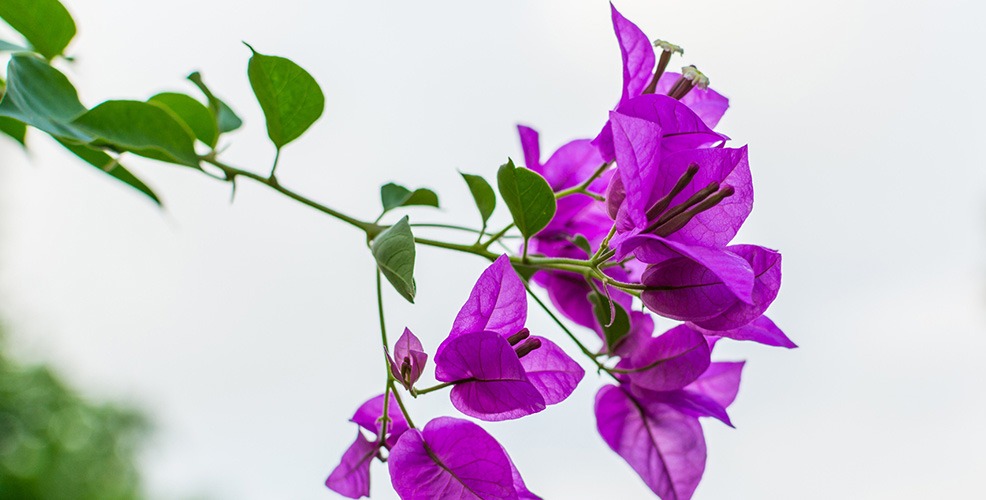
7. Avoid excessive watering
After planting, water your bougainvillea once a week until it becomes established, which can take up to three years. Once established, watering is necessary only during drought conditions when natural soil moisture is depleted. Overwatering should be avoided, as it encourages root rot. Bougainvillea plants prefer well-drained soil and do not thrive in waterlogged conditions.
8. Pest control
Bougainvilleas are generally resistant to diseases and pests. However, aphids, leaf miners, bacterial and fungal leaf spots, scale insects, thrips, spider mites, slugs, snails, and caterpillars may occasionally infest bougainvillea plants. To prevent pest and disease issues, avoid planting near diseased plants. If you encounter any of these pests or diseases, you can address them using insecticidal soap, neem oil, or narrow-range oil.
9. Prune regularly
Pruning plays a crucial role in the overall care of bougainvillea, but it presents a delicate balance. On one hand, pruning serves as a preventive measure to control excessive growth and unwanted patterns of growth. On the other hand, pruning actively encourages the emergence of fresh and exquisite bougainvillea blooms. Both of these outcomes resulting from pruning are essential for the health and well-being of bougainvillea plants. While pruning can be conducted at any time, it holds particular significance at the onset of the growing season.
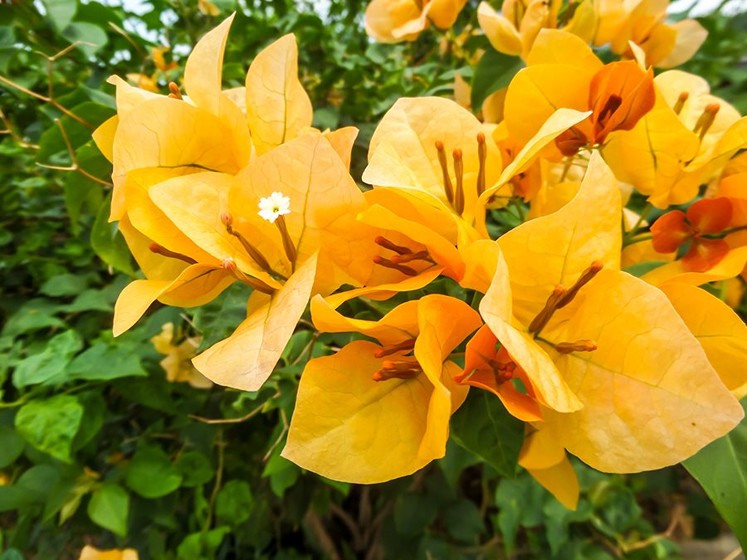
Creative Ways to Utilize Bougainvillea
Utilizing Bougainvillea in your garden offers numerous opportunities to highlight the plant’s unique features. Here are several ways to incorporate bougainvillea into your garden:
• Hanging baskets
Opt for dwarf varieties such as B. glabra or Bambino bougainvillea when planting in hanging baskets. These smaller plants establish roots more effectively in confined spaces, and you’ll have to prune them less frequently. Keep in mind that the soil in hanging baskets dries out faster, necessitating more frequent watering.
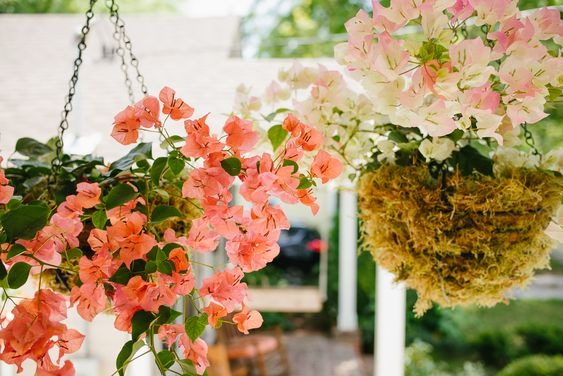
• Ground cover
Bougainvillea thrives when given ample space to spread out, making it an excellent choice for filling empty spots in garden. Plant them in well-drained areas elevated enough to avoid water logging since bougainvillea prefers drier conditions.
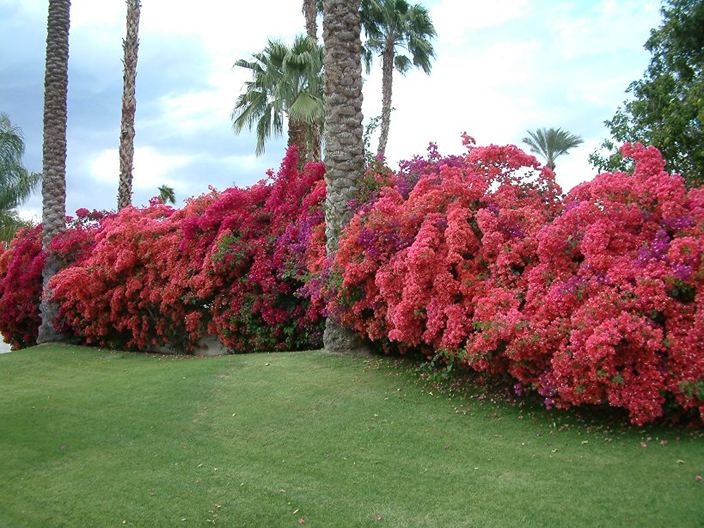
• Potted plants
Bougainvillea can be planted in pots, either indoors or outdoors, as long as they receive ample sunlight. While bougainvillea can tolerate lower light conditions if new growth is not a priority, they thrive best in full sun. Select a pot that is approximately twice the size of the plant to accommodate its growth.
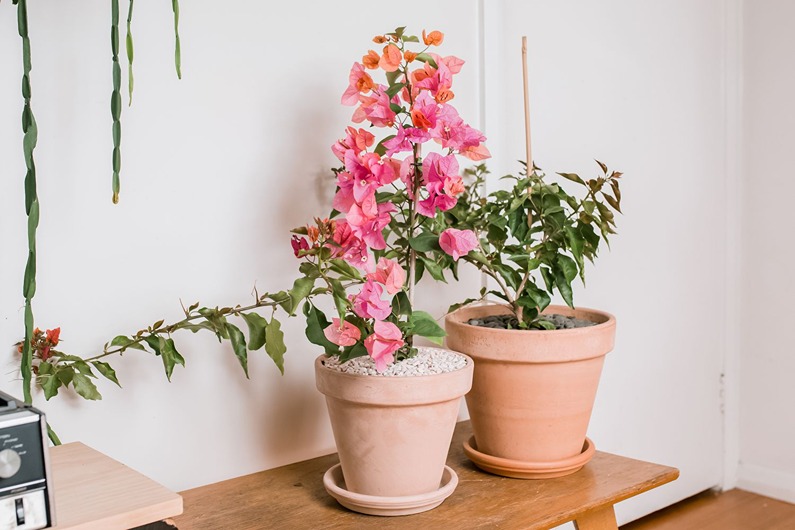
• Climbing plant
Bougainvillea naturally exhibits climbing tendencies, making it a popular choice for trellises, arches, or fences. The plant requires a supportive structure to latch onto, with chain-link fences serving as particularly effective supports.
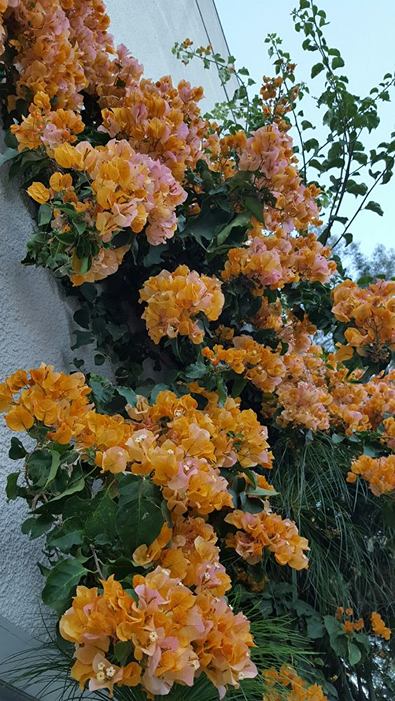
• Bonsai
Bougainvillea is well-suited for bonsai cultivation due to its excellent tolerance for pruning. Regular pruning is essential for the plant’s health, making it an ideal candidate for bonsai styling—a practice involving the constant pruning and shaping of ornamental trees or shrubs to maintain their desired size and appearance.
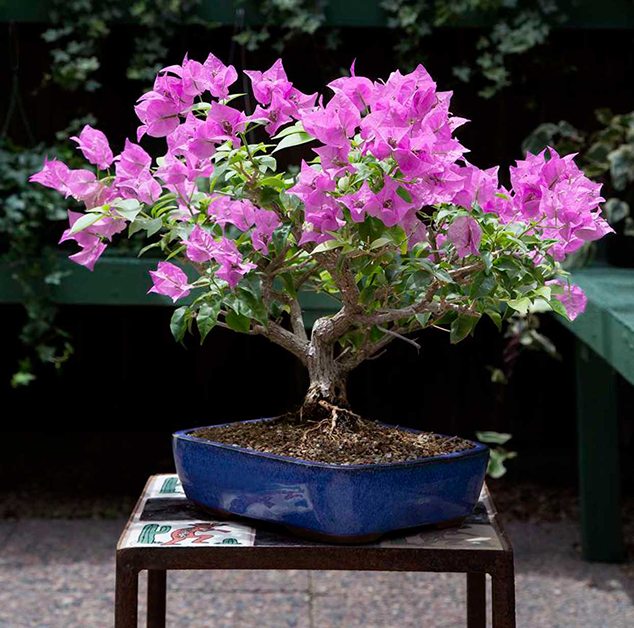
Most Recommended Bougainvillea Varieties
Discover a wide range of recommended bougainvillea varieties, each boasting its own distinct characteristics and vibrant blooms. Here are some notable selections:
- Afterglow: A prolific bloomer featuring yellow-orange blossoms.
- Barbara Karst: A popular and vigorous grower known for its abundant clusters of magenta blooms throughout the summer and fall. This variety can climb up to 40 feet in height.
- California Gold: One of the top-performing yellow bougainvillea varieties, capable of climbing up to 30 feet.
- Imperial Delight: This variety showcases pink and white blooms during the summer and exhibits greater cold-hardiness, suitable for cultivation in Zone 9 and beyond.
- James Walker: With its striking red-purple blooms, this variety blossoms year-round in frost-free zones.
- Purple Queen: Boasting deep purple blooms, this variety can reach a height of 15 feet with appropriate support, or grow as a 1-1/2 feet tall groundcover.
- Sundown Orange: Known for its bracts that transition from deep orange to salmon and eventually fade to coral, this variety can climb up to 20 feet and withstand high heat conditions.
- Bengal Orange: Featuring pink-orange blooms, this variety stays relatively compact, reaching a height of just 1.5 feet, or spreading 6 to 8 feet wide when grown as a ground cover.
- Rosenka: Exhibiting golden pink blooms, this variety grows 1 to 2 feet tall and 3 to 4 feet wide.
- Singapore White: Characterized by its white blooms, this thornless semi-dwarf variety reaches a height of 2 to 3 feet. It demonstrates excellent tolerance to high heat and humidity.
- Helen Johnson: A true dwarf bougainvillea, this hardy shrub stays under 3 feet in height and showcases vibrant hot pink blooms.
- Pixie: Another true dwarf variety, ‘Pixie’ grows in dense tufts of thick branches, displaying a shrub-like growth habit. With a height of less than 3 feet, it produces charming pink blooms. Originating from the Philippines, it is often trained as a bonsai.
